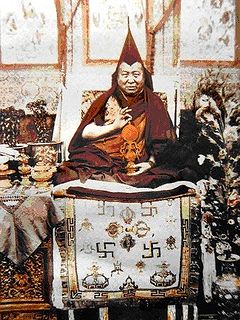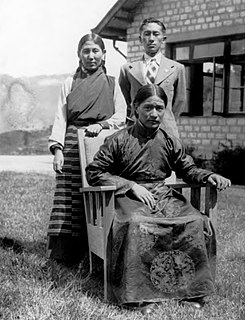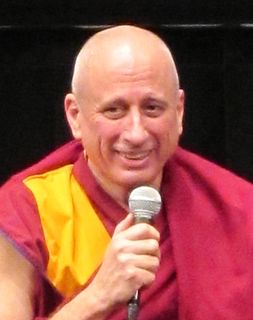
Dalai Lama is a title given by the Tibetan people to the foremost spiritual leader of the Gelug or "Yellow Hat" school of Tibetan Buddhism, the newest of the classical schools of Tibetan Buddhism. The 14th and current Dalai Lama is Tenzin Gyatso, who lives as a refugee in India. The Dalai Lama is also considered to be the successor in a line of tulkus who are believed to be incarnations of Avalokiteśvara, the Bodhisattva of Compassion.
Chökyi Gyalpo, also referred to by his secular name Gyaincain Norbu or Gyaltsen Norbu, is considered the 11th Panchen Lama by the government of the People's Republic of China. He is also the vice president of the Buddhist Association of China. Gyalpo is considered by some to be a proxy of the government of China.

Jamphel Gyatso (1758–1804) was the 8th Dalai Lama of Tibet.

Kelzang Gyatso, also spelled Kalzang Gyatso, Kelsang Gyatso and Kezang Gyatso, was the 7th Dalai Lama of Tibet, recognized as the true incarnation of the 6th Dalai Lama, and enthroned after a pretender was deposed.

Pabongkhapa Déchen Nyingpo, (1878–1941) was a Gelug lama of the modern era of Tibetan Buddhism. He attained his Geshe degree at Sera Mey Monastic University, Lhasa, and became a highly influential teacher in Tibet, unusual for teaching a great number of lay people. Pabongkha was offered the regency of the present Dalai Lama but declined the request because "he strongly disliked political affairs."

Kyabje Dudjom Jigdral Yeshe Dorje known as Terchen Drodül Lingpa and as Dudjom Rinpoche, is considered by Tibetan Buddhists to be from an important Tulku lineage, a renowned Tertön treasure revealer and a direct incarnation of Padmasambhava and of Dudjom Lingpa (1835–1904). He is a Nyingma householder, yogi, and a Vajrayana and Dzogchen master, and according to disciple Khenpo Tsewang Dongyal is referred to by them as "His Holiness" and as a "master of masters".

Palpung Monastery is the name of the congregation of monasteries and centers of the Tai Situpa lineage of the Kagyu school of Tibetan Buddhism as well as the name of the Tai Situ's monastic seat in Derge, Kham. Palpung means "glorious union of study and practice". It originated in the 12th century and wielded considerable religious and political influence over the centuries.
Shabdrung Lama Kunga Thartse Rinpoche is a Tibetan teacher of the Sakya school of Vajrayana Tibetan Buddhism. Lama Kunga Rinpoche is licensed in California to perform marriages with a Tibetan Buddhist ceremony.
Taktser Rinpoche was born in 1922 in "the small village of Taktser, meaning 'roaring tiger,' located in the Amdo region of eastern Tibet." He became a lama of the Gelugpa school of Tibetan Buddhism and was named Thubten Jigme Norbu, the oldest brother of Tenzin Gyatso—the 14th Dalai Lama of Tibet. Soon after birth, he was recognized by the 13th Dalai Lama as the reincarnation of the previous Taktser Rinpoche, who was "one of the thirty or so reincarnated lamas who were a part of Kumbum's tradition." On September 5, 2008, Norbu, 86, died at his Indiana, US, home after illness for many years. He was survived by his wife Kunyang Norbu, and 3 sons.

Kumbum Monastery, also called Ta'er Temple, is a Tibetan gompa in Lusar, Huangzhong County, Xining, Qinghai, China. It was founded in 1583 in a narrow valley close to the village of Lusar in the historical Tibetan region of Amdo. Its superior monastery is Drepung Monastery, immediately to the west of Lhasa. It is ranked in importance as second only to Lhasa.
Zong Rinpoche was a Gelug Lama and disciple of the third Trijang Rinpoche, junior tutor of the 14th Dalai Lama. He was famous as a sharp analyst and master of philosophical debate, as well as a powerful Tantric practitioner. He was the Abbot of Ganden Shartse monastery.

Katok Monastery, also transliterated as Kathok or Kathog Monastery, was founded in 1159 and is one of the "Six Mother Monasteries" in Tibet of the Nyingma school of Tibetan Buddhism, built after Samye Monastery. It is located in Payul, Karze Prefecture, Sichuan, China, known as Kham.

Rato Dratsang, also known as Rato Monastery, Rato Dratsang is a Tibetan Buddhist monastery of the Gelug or "Yellow Hat" order. For many centuries Rato Dratsang was an important monastic center of Buddhist studies in Central Tibet.
Loden Sherab Dagyab Rinpoche was born on July 27, 1940 in Menya, East Tibet. He was recognized as the reincarnation of the 9th Kyabgoen at the age of four. The Dagyab Kyabgoens have been the spiritual heads of the Dagyab region in Eastern Tibet, and carry the title Hothogthu Nomonhan. 'Hothogthu’ means noble, ‘Nomonhan’ refers to the King of Dharma. This title is exclusive to a small group of the most outstanding and highest-ranking incarnate Lamas, often reincarnations of Regents of Tibet. Dagyab Rinpoche is the only Hothogthu living in the west. The lineage of the Kyabgoens, “Lords of Protection” of the Dagyab region of Tibet, goes back to Dragpa Gyatso.

Kyabje Yongzin Ling Rinpoche is a Tibetan tulku. The best-known incarnation is the sixth incarnation, Thupten Lungtok Namgyal Thinley, a Tibetan buddhist scholar and teacher.

Khyongla Rato, also known as Khyongla Rato Rinpoche, Rato Khyongla Rinpoche, Khyongla Rinpoche and also as Nawang Losang, his monk's name, is a scholar and teacher in the Gelugpa tradition of Tibetan Buddhism. He was born in what was then the Kham region of Tibet, and was recognized as an incarnate lama at an early age. He spent over 30 years of his life as a monk studying in the monasteries of Tibet and receiving teachings from many highly qualified lamas.

The Tibet Center, also known as Kunkhyab Thardo Ling, in New York City, is a center for the study of Tibetan Buddhism, a dharma center. The Tibet Center was founded by Venerable Khyongla Rato Rinpoche in 1975, and is currently directed by Khen Rinpoche Nicholas Vreeland, who is also the abbot of Rato Dratsang. The primary teachers at The Tibet Center are Khyongla Rato Rinpoche, Geshe Nicholas Vreeland, and Anthony Spina.

Nicholas Vreeland, also known as Rato Khen Rinpoche, Geshe Thupten Lhundup, is a fully ordained Tibetan Buddhist monk who is the abbot of Rato Dratsang Monastery, a 10th-century Tibetan Buddhist monastery reestablished in India. Vreeland is also a photographer. He is the son of Ambassador Frederick Vreeland and grandson of Diana Vreeland, the renowned fashion editor.

Kyabje Khensur Kangurwa Lobsang Thubten Rinpoche, was a Buddhist monk, Abbot of Sera Jey Monastery, and the founder of Tibetan Buddhist Institute (Adelaide). Khensur means "former abbot" and Rinpoche means "precious teacher."














